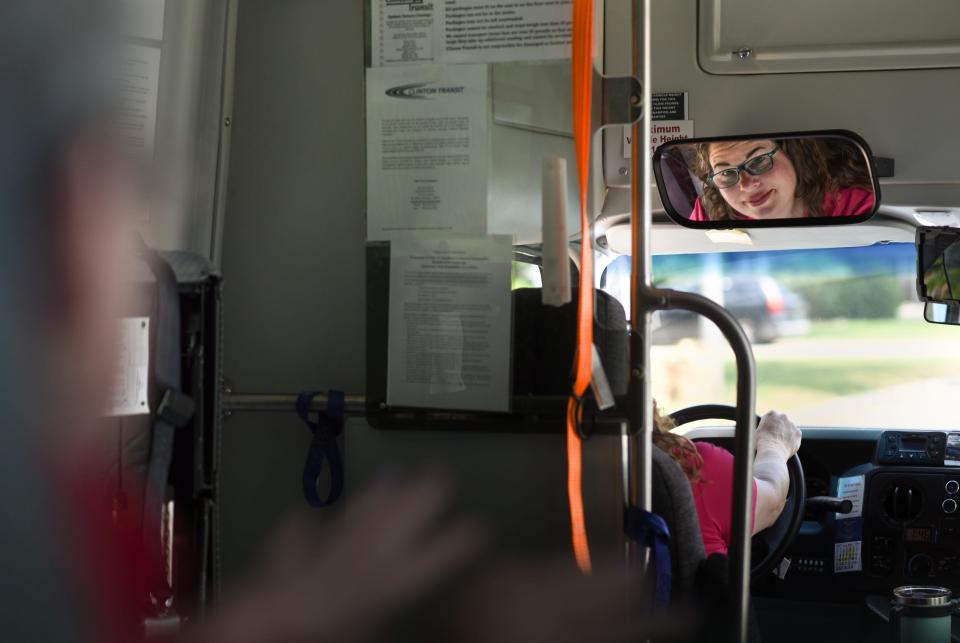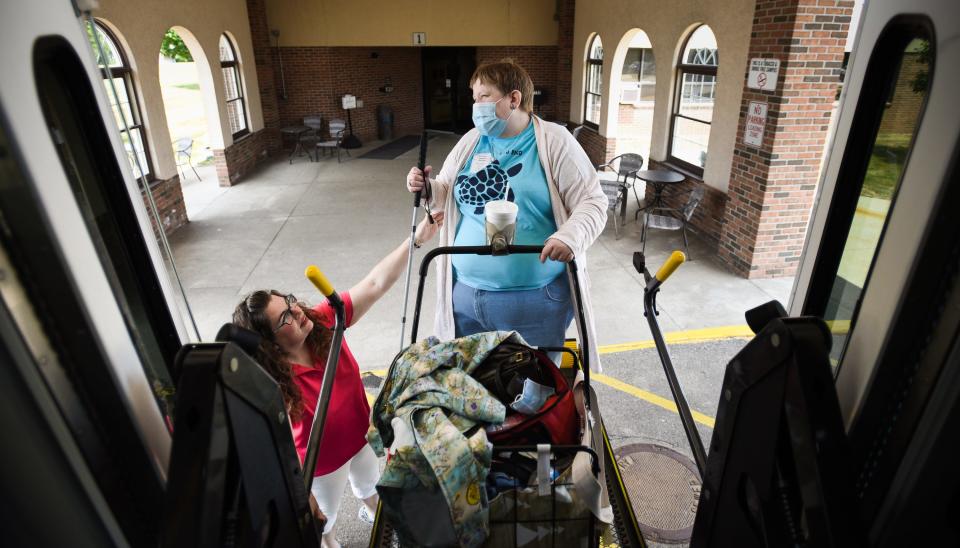Clinton County is bucking trend in public transit ridership. Here’s why
Correction: 1,000 riders a month from Clinton County into the Lansing area will count half for CATA and half for Clinton starting this fall, under a new cooperative deal involving the area transit systems. An earlier version of this story incorrectly stated how Clinton County Area Transit riders will be counted.
ST. JOHNS — As the blue bus stopped in front of her apartment, Marion Marek stepped outside, walked to the curb and hopped on, headed to her job as a Kroger cashier and sparing herself an hour's walk.
In addition to saving her time getting to and from work, Marek credits the blue bus and the rest of its fleet with perhaps saving her life. She used the Clinton Area Transit System's blue buses to reach her cancer treatments.
"If it wouldn't have been for these guys and Miss Molly there," Marek said, trailing off and wiping at her face before she could finish.
On driver Molly Berger's bus, it's clear the rural transport system means a lot.
"They're like family," she said. "There's a reason people come here."

The Clinton Area Transit System has provided about 75,000 rides in the past year, and Marek's rides contributed to a positive trend.
While the Clinton Area Transit System has posted strong ridership numbers since the COVID-19 pandemic, most transportation systems in the state continue to struggle, including those in Eaton and Ingham counties. In the first quarter of 2023, the state's more than 75 transit systems reported that more than 40% of the state's pre-pandemic riders hadn't returned, according to Michigan Department of Transportation figures.
Brad Funkhouser, CEO of Capital Area Transportation Authority and executive director of Eaton County Transportation Authority, said his two systems are each at 63% of their pre-pandemic ridership numbers — and climbing.
"I’ve found that’s pretty consistent across America in transit authorities," Funkhouser said, adding that since the pandemic, transportation systems in more urban areas have faced greater challenges getting riders to come back than in rural areas.
Funkhouser lauded the work Clinton Transit officials have done in recovering from ridership losses during the pandemic.
MaLissa Schutt, Clinton Transit's executive director, credits good timing, a millage approved by voters in 2020 and geography as some of the reasons the small bus system has recovered faster than most systems in the state.
"It feels like people are hearing about us, even if they never did before," she said. "I think marketing is a part of it. But I can't market what I don't have. We have the support of the community. They recognize the value that we contribute of being able to get people to work, getting them to medical care and getting grandma to see her grandson's soccer game or baseball game. That's what we're here for. And those trips are just as important, right?"
'Our heads are still spinning'

Clinton County voters renewed an existing millage and approved a 0.5-mill increase in 2020 to boost operations at the rural bus system. One of the biggest demands was to begin transit routes into Lansing.
Schutt said the service now schedules at least 15% of its routes into Ingham County, which has helped boost ridership.
Clinton Transit also added a Saturday route. Schutt worked in dialysis treatment and transportation when she joined the transit system in 2019, and she expected Saturday rides to be largely medical. Instead, she met people riding to their jobs.
"The typical rural transit is medical and then employment. We've flipped that around," she said.
The Clinton Area Transit System counted 74,600 rides between May 2022 and May 2023, a 43% increase over its May 2018 to May 2019 ridership, she said.
"Our heads are still spinning a little bit like, wow, we made all the decisions at the right time, with the right people in place," she said.
Clinton Transit posted the third-best recovery in the state at the end of March, nearly tying with Niles' Dial-a-Ride and Hancock's city transit.
Fewer than 10 of Michigan's transit systems have surpassed their 2019 ridership levels.
What about CATA and EATRAN?

State figures that compare first-quarter ridership from 2019 to 2023 show Detroit is one of the furthest behind in ridership. The Detroit Department of Transportation reported about 6.4 million rides in the first three months of 2019, and about 2.7 million for the same period of 2023.
Data show CATA and EATRAN also have a long way to go to recover from ridership losses since the pandemic.
CATA is split into two parts, an urban system and a rural system. The more urban system saw ridership fall from 3 million in 2019's first quarter to 2 million for the same period of 2023. For the rural system, rides fell from 13,229 in the first quarter of 2019 to 4,642 for the same period of 2023.
CATA officials said the system is expecting to get 7 million rides for the full year, compared with 11 million in 2019.
Eaton County Transit Authority reported 35,455 rides in the first quarter of 2019 compared with 18,551 for the same period in 2023.
For EATRAN, Funkhouser said new routes — like one for the Lansing Mall, which is adding 450 riders a week — are one way the service is looking to expand.
CATA is considering a route to the Capital Region International Airport.
And major changes are coming to the way EATRAN, CATA and Clinton Transit operate.
The three systems have begun working together in a way that will reduce official ridership numbers but move them more efficiently. The three systems used to essentially stop at the county borders, but last fall they struck a deal to take passengers into each other's territories.
"Ridership is kind of a false variable, but it's used to measure how you get money from the state," Funkhouser said. "If we require a transfer at the county line, I’d be able to add a trip to my system. Clinton gets a trip, too. But the rider has to get out. Our ridership is up and our boards are happy and both of us get to bill the state for operating. I think that’s silly."
For example, 1,000 riders a month from Clinton County will count — half for CATA and half for Clinton —starting this fall, which will boost CATA's numbers by 500, but reduce Clinton's transit numbers, Funkhouser said.
It won't change how many people get to where they want to go, and most riders would prefer to not have to switch buses, he said.
Contact Mike Ellis at mellis@lsj.com or 517-267-0415
This article originally appeared on Lansing State Journal: Clinton County is bucking trend in public transit ridership. Here’s why
